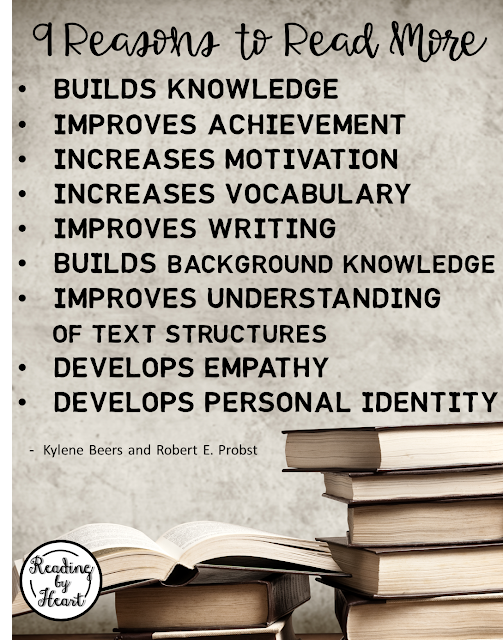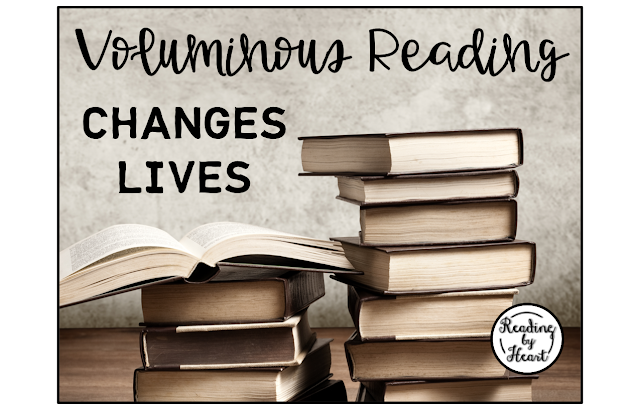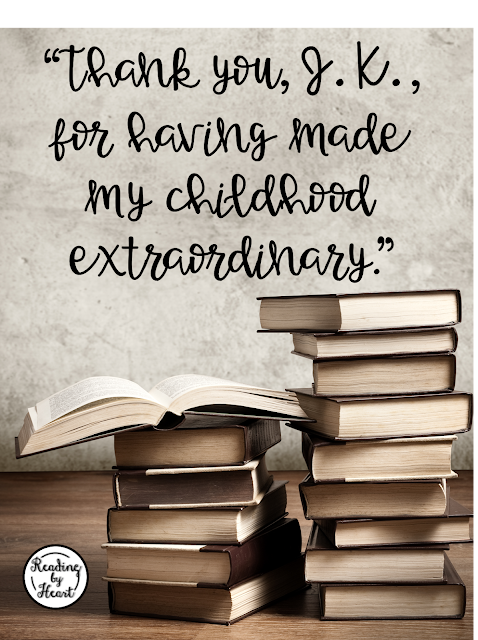"The best intervention is a good book."
READING MAKES READERS
Volume reading is crucial to transforming striving readers into thriving readers, say Stephanie Harvey and Annie Ward. They believe that voluminous, pleasurable reading is the key to literacy development. In this post we'll look at Chapter Four, "Pump Up the Reading Volume." The authors discuss how voluminous reading changes lives, reasons to add more reading to our day, how to build in more reading time, and review the research.
REASONS TO
READ MORE
Kylene Beers and Robert E. Probst in their book, Disrupting Thinking: Why How We Read Matters (2017) outline the many benefits of volume reading. In addition to honing the skills that come with experience with text, extensive reading builds background knowledge, increases vocabulary, improves writing, develops empathy, and helps a reader develop their personal interests and goals.
LOGGING MILES IN BOOKS
Readers gain skill from experience. Reading countless texts gives readers navigational experience. They learn how texts work. When they encounter italics, or flashbacks, they think, "Oh, I've seen this before." Veteran readers recognize and understand text structures.
VOLUMINOUS READING
CHANGES LIVES
The authors believe that through a high volume of reading, children become not only more skillful readers, but more informed, principled, empathetic people.
They cite research by psychologist Loris Vezzoli in Italy (2015), using Harry Potter, in which children were surveyed about their attitudes toward immigrants and refugees. The children who read passages from Harry Potter books in which Harry reacted empathetically against the persecution of "mudbloods" demonstrated significantly greater compassion than those in control groups who read more factual passages about topics such as Harry's first wand purchase.
Researchers at the Yale University School of Public Health (2016) found those who read books for a half-hour a day had an average "survival advantage" of two years over those who didn't read books.
The results of the British Cohort Study (which followed over 17,000 people born in England, Scotland and Wales within the same week) showed that children's pleasure reading has been linked more to their cognitive development and academic success than their parents' levels of education.
Included on page 138 is a picture Annie captured of the restroom wall of The Elephant House, in Edinbugh, Scotland, where J.K. Rawling wrote much of her Harry Potter series. Among the scribbled messages scrawled from floor to ceiling is this one: "Thank you, J.K., for having made my childhood extraordinary." Another is a thank you to "A. Dumbledore - for the life lessons."
BUILD IN TIME FOR STUDENTS
TO READ INDEPENDENTLY
"An unhurried block of independent reading should be the centerpiece of our reading curriculum."
The authors believe it's our responsibility to proactively create and protect time for readers to read in our classrooms. But how to find time to read during the school day?
Start the Day
Stephanie advocates for beginning the school day with a half hour of independent reading when students are fresh and focused.
One of the things I've liked best about scheduling time for independent reading at the beginning of the day is the peaceful, calm, relaxed way we start the day together. It's a time for children to focus on themselves, exploring their personal goals and interests as they read.
Harvey and Ward cite a 2009 study from the University of Sussex illustrating the calming benefits of reading. "Six minutes of engaged reading was found to reduce subjects' stress levels by 68 percent."
Reading Workshop
Reading Workshop is an instructional model that provides for a minimum of 45 minutes of supported independent reading. Teachers are actively teaching one-one or small group during this time.
School-wide Reading
Some schools establish a school-wide reading time each day.
In my own school, we created several school-wide opportunities to read. Once a month my Americorps assistant and I took the entire school in the multipurpose room to read while the staff met to work on goals. Readers got comfortable on the carpet with blankets, stuffed animals and their backpacks and read together for 50 minutes.
We also conducted all-school reads, in which everyone came out into the hall, settled in with their comfort blankets and animals, and read. It was a powerful feeling to see so many readers enjoying their own books all at once.
Once a year (3rd-5th grade school), we hosted "Read a Book in a Day" Day. Kids spent the entire day reading a self-chosen (short) chapter book from start to finish. Supports were put in place to make sure each student was able to succeed at the challenge. Every student upon completion of their chapter book received a certificate. A reading celebration assembly was held in which readers who met the challenge (everyone, because of the supports) earned a piece of tape to publicly tape my assistants and I to our chairs.
"Read a Book in a Day" Day helped our striving readers see in concrete terms that they CAN read and complete a daunting book in a timely manner!
For those interested in further consideration of the whys and hows of volume independent reading, I recommend Debbie Miller and Barbara Moss’s book No More Independent Reading Without Support (2013). It’s a part of Heinemann’s Not This But That series. Only 72 pages, it’s a very quick read!
Miller and Moss devote a significant portion of this book to presenting us with brainstormed ways to squeeze extra minutes out of our busy days to find more time for kids to read independently.
They also advocate convincingly that we must spend our students' independent reading time actively supporting readers (conferring, observing, teaching, encouraging, book-finding, data collecting, etc.) Gone are the days of SSR’s mandate for teachers to model their own reading while students are reading.
REMOVE BARRIERS
TO VOLUME
How can we ensure our students are engaging in volume reading in our classrooms? Harvey and Ward suggest examining the curriculum and daily schedule for help in removing barriers.When we craft a unit - for example, a genre study of mysteries, the authors suggest asking ourselves if the unit contains suitable reading material for all readers. Shared texts may not be accessible to some readers. Some may be unable to read the text, while others may find the material unengaging. These readers will lose valuable reading time for the duration of the unit.
They suggest, instead, we “crack open” curriculum units using a broader array of texts, offering more choice and differentiation, while still covering the intended curriculum skills.
Other Ideas the Authors Propose:
Response-to-Reading
Response-to-reading should encourage readers to “think deeply, talk with others, or pick up another book.”
Mike Schmoker’s phrase “Crayola Curriculum” describes the busy work of coloring, cutting and diorama-building response-to-reading that the authors call “inauthentic, time-sucking volume-robbing monsters!” They argue, instead, that striving readers use this time for much-needed reading.
Logging reading should be time-efficient and also allow readers to reflect on their progress.
Transition Reading
For readers who are still lingering in “book hangovers” after finishing particularly compelling reads, the authors suggest helping kids find short texts, perhaps on related topics, to continue reading during this transition time. Allow readers to extend their reading into YouTube videos, news articles, etc.
Keep Reading!
Pick up a “next-up book” and move on! Keep going! Next up might be a lighter read, or the continuation of a series, an easier read for fluency practice, or an atypically difficult read for a taste of challenge. In the authors’ minds there is no ‘right’ next-up book! Just keep reading!
Value Home Reading
The authors suggest we take care to monitor what we send home for homework. If we load kids down with a folder full of busywork, what does that say about how much we value our students’ reading at home?
Reading More Effective Than Test Prep
Research was presented to indicate that volume reading is more effective than test prep.
QUESTIONS TO ASK
The authors pose several categories of questions for teachers to consider: Self-Questions, Kidwatching Questions, and Conferring Questions.
My favorite Self-Question was: “Do I confer regularly with kids about their reading and reading materials to ascertain their level of engagement?” Observation is my favorite tool to monitor readers’ engagement: time on task, timely progression through books, engaged body language, a nonverbal “thumbs up?,” and a “How’s it going?”
The Kidwatching Question that caught my attention was “Does the student abandon books? If so, is there a pattern?” This is a recurring concern for some of my striving readers and something I often struggle with.
My favorite Conferring Question is “Do you think this author has written anything else? Let’s check…” Helping readers find “more like this” is a big part of what I do during supported independent reading.
The authors’ complete list of questions we can ask ourselves is on page 139.
Stephanie and Annie conclude this chapter on Pumping Up the Reading Volume by stating, “Readers author their lives through their choice of books, and those choices expand readers’ abilities while opening their hearts.”
One of my favorite parts of this chapter is Annie’s anecdote about her reading conferences with Elijah, who was reading C. Alexander London’s Dog Tags series about soldiers and dogs. In Elijah’s current read, Semper Fido, the protagonist has to decide whether to shoot his dog to keep him from giving away the platoon’s position. Elijah confided to Annie he almost cried, then showed her the dog tags included with the book now on a chain around his neck. He whispered, “I don’t take it off.”
Annie recounted hearing Mem Fox say, “Children’s hearts need to ache with caring over what they read.”
I've written about how voluminous reading can change lives. You can read about it here.
Recommended Reading
- Disrupting Thinking: Why HOW We Read Matters, Kylene Beers and Robert E. Probst (2017)
- No More Mindless Homework, Kathy Collins (2017)
- No More Independent Reading Without Support, Debbie Miller and Barbara Moss (2013)
“If They Don’t Read Much, How They Ever Gonna Get Good?” - Richard Allington
Researchers to Know
- Richard Allington, researcher at the University of Tennessee and past President of the International Literacy Association, whose 1977 article title sums up his four decades of reading volume advocacy.
- Stephen Krashen, Professor Emeritus at the University of Southern California found that “reading volume was the single greatest factor in reading achievement.”
- Anderson, Wilson and Fielding (1988) found that “the amount of time students spent in independent reading outside of school was the best predictor of reading achievement.” They correlated minutes read per day and words read per year to percentile scores on standardized tests.
OTHER POSTS IN THIS SERIES:
- Introduction
- Chapter 1-Table the Labels
- Chapter 2-Cultivate Curiosity
- Chapter 3-Ensure Access to and Choice of Books
- Chapter 4-Pump Up the Reading Volume
- Chapter 5-Book-Match Relentlessly
- Chapter 6-Teach Thinking-Intensive Reading
- Chapter 7-Assess Readers in the Round
- Chapter 8-Advocate Tirelessly
- Synopsis and Supplemental Materials
 from Reading by Heart |














This is excellent! I love the quotes you included in your post.
ReplyDeleteThanks so much, Sandy! I enjoyed the chapter, and was pleased to find such great quotes!
ReplyDeleteAs soon as I finish commenting, I'm heading over to Amazon to put this book on my wishlist. Thanks for sharing!
ReplyDeleteJan
Laughter and Consistency
Jan, you're welcome. Yes! I've always loved Stephanie Harvey and now I love Annie Ward, too! The subtitle of their book is "How to Grow Confident, Capable Readers." What a great topic!
Delete